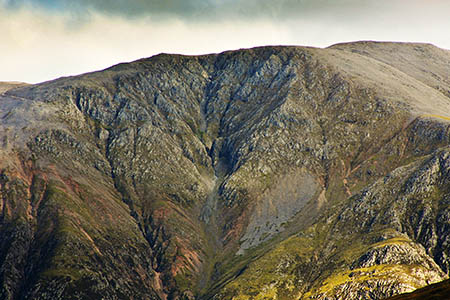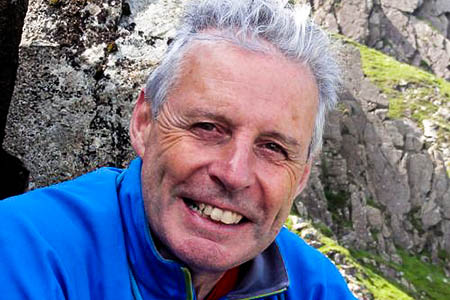A mountain expert is warning walkers they face cold conditions on Scotland’s high peaks, despite it still being August.
Sleet and even snow was forecast for the country’s highest munros this week, and hillwalkers should go equipped for cool and wet conditions, the Mountaineering Council of Scotland said.
Torrential wind and gales last week led to flooding in parts of the Highlands, with bridges on popular Cairngorms routes washed away.
The MCofS said hypothermia is a real risk if people are not properly prepared.
Temporary mountain safety adviser David ‘Monty’ Monteith said: “Sleet has been forecast for the higher hills in the coming week, and we’ve just seen torrential rain which swept away two bridges in the Cairngorms and made many streams impassable for a period, as well as causing landslips and damage to footpaths.
“Wind and rain are the classic combination for bringing on hypothermia. Once someone’s clothes are wet through the wind can have a tremendous chilling effect, even though the air temperature is not that low in itself.”
He pointed out hypothermia occurs when a person’s body temperature drops below 35°C, normal body temperature being around 37°C. Hypothermia can quickly become life-threatening and should be treated as a medical emergency, he said.
The MCofS said anyone planning a day in the mountains should make sure they check the weather forecast, with mountain-specific forecasts available from MWIS and the Met Office. There is also the BBC outdoors forecast on BBC Radio Scotland at weekends, it said.
Mr Monteith said: “Walkers should also consider a simpler, low-level route option or plan a viable escape route if they are aiming to go high. The provision of a bivouac bag, group shelter and some modern lightweight insulating clothing can be a lifesaver if things do go wrong.
“Add to this some first aid knowledge and the ability to convey an emergency message and preparations are in good order.
“The medium-term weather forecast is for some respite in the wet and cold weather but this will only be temporary. The nights are now drawing in and next month sees the autumnal equinox, after which the number of daylight hours shrinks noticeably.
“Make sure you don’t shrink from responsible preparations for your mountain journeys.”
More advice can be found on the MCofS website.


R K
20 August 2014I'd never ever have thought of checking the weather forecast before I go into the hills and am grateful to the MC of S for the advice.
Come on MC of S stop playing at nanny or you will end up being ignored when you do have something to say.
SH
20 August 2014RK, good point and I understand! But I just think they're being cautious because of the unseasonably low temps recently. People may be coming to Scotland thinking it won't be too bad because it's August and therefore 'warm', despite weather forecasts. Probably helpful for some people, as are the navigation tips. But you're right, too much of this and people may not read so rigorously - tricky balance with the numbers and variation of people coming up.
jhimmy
20 August 2014On 11/09/2012 at the top of Derry Cairngorm I was in a brief but fierce hail storm. Having just passed over the top on the rocky descent the hail was so bad and stinging, I couldn't see where my feet were treading. Luckily I was fully suited up. But the temperature was bitter by the time I got to the top of Ben McDui.
I have picture of Ben MacDui in a thin layer of snow and blizzard streaks. As I huddled in one of them shelters, I was surprised by a fell runner in shorts, tee shirt and trainers jogging to the cairn and back the way he came (actually I took a video of him doing it).
Yes, I was a wimp that early September day.
Mountain Chap
21 August 2014R K, clearly this article is not aimed at someone such as yourself. We cannot assume that everyone that heads to the hills will check the weather before heading out and even if they do it may not be a mountain specific site such as MWIS or Met Office Mountain Area.
Often inexperienced outdoor folk are not aware of the difference between the weather found at sea level and at the summit of a mountain. There will be those that call that this kind of thing is 'common sense,' but I would disagree based on my work as a Mountain Leader who trains and takes 'newbies' out on to the hills.
For example if BBC weather says 14 degrees in Fort William, then without prior experience, mountain training or qualifications in Geography/Meteorology then it is quite common for someone to assume that Ben Nevis will be 14 degrees at the top as they don't know any better.
Therefore I believe it is important the organisations such as BMC, MCofS release statements like this. I agree that people who access forums such as this may already know about 'basics' such as this, however the general public may not. It is important that these statments are as widely circulated to the general public as possible to help increase safety on UK's mountains.
It is up to not only the various Mountain Council's but also those of us who do have the knowledge and experience to increase education, awareness and safety on the hills to do so. The next time MCofS/BMC do one of their 'nanny' statements, have a think about the intended receipient of it and the possible reasons/timing for it!
Mark
21 August 2014I have seen some proper pricks up in the mountains - I once passed somebody in flip flops on top of Ben Nevis with no warm clothing and in the rain. It cannot be said too often - particularly as these are the guys risking their own lives getting people down again.
R K
22 August 2014SH, I'm a member of the MCofS and supportive of them but one thing I like about the hills is the ability to get away from the 'hi-viz' culture we have around about us in everyday life, this advice reminded me of that a bit.
I see what you are saying - I suppose they have to issue advice aimed at the least aware and in the big scheme of things I can live with that.